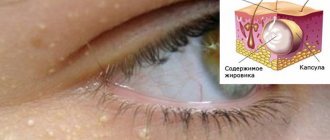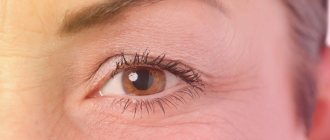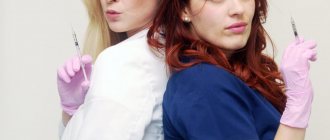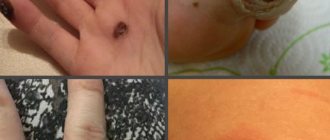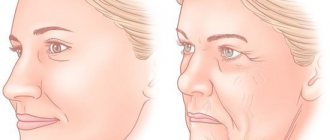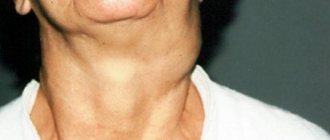In the modern world there are almost no women left who have not heard about Botox. One of the most popular ways to use it is by injection into the area around the eyes to smooth out crow's feet. This is where the skin is thinnest and most delicate, and expression lines appear first. Already at the age of 25-27, girls decide to take the dangerous path of so-called Botox rejuvenation, which sucks in like a quagmire and turns beautiful faces into ugly masks. This is partly to blame for the lack of awareness about the insidiousness of this procedure, which only seems effective. Cosmetologists don’t tell the whole truth about botulinum poison. We bridge knowledge gaps.
Effect of Botox on eyelids
The skin in the eye area is thin and delicate, so it is more susceptible to age-related changes than other areas of the face. In girls with active facial expressions, “crow’s feet” (facial wrinkles in the area of the outer corners of the eyes) appear at the age of 25 or earlier.
Signs of age on the face occur when blood circulation deteriorates, the structure of the dermis and muscle function change. The skin becomes less collagen, elastin, some fats, and water, which is why it loses strength and elasticity and begins to sag. And the muscles become overstrained from constant work. In the case of the eyelids, the orbicularis muscle, which is responsible for opening and closing the eyes, experiences a lot of stress.
How does this affect your appearance? Grooves and folds appear around the eyes. The upper eyelid droops (ptosis).
Combating these signs of aging is one of the most popular uses of Botox. How does it work?
Botox is a medical drug that contains the strongest poison botulinum toxin. It blocks the transmission of nerve impulses to the muscle, causing it to become paralyzed. The muscle stops contracting and stretching the dermis. The configuration of the muscular system and the vector of skin tension change. The drug is injected into the muscle through injection.
For what purposes is Botox done on the eyelids:
- smoothing out wrinkles,
- raising the upper eyelid and lowering the lower eyelid, opening the gaze,
- correction of eye opening asymmetry,
- raising eyebrows.
This article does not cover the medical uses of Botox used to treat strabismus, eye tics, and other uncontrollable muscle spasms and eye disorders.
Efficiency
The effect of Botox lasts, on average, 1-5 months. Then the result disappears. Manufacturers of some drugs containing botulinum toxin claim 9 months as the maximum duration of effect, but in practice this does not happen. In some cases, Botox does not produce any results.
Remember! Botox does not solve the problem of age-related changes in the eyelids, but only creates temporary appearance. You have to pay for a fleeting illusion with health and beauty. Botox disfigures the face, is toxic to the body and - attention! – accelerates the aging process. It is a poison that only causes harm.
We prove what cosmetologists are silent about or mention in passing as something incidental and insignificant.
Pros and cons of Botox for eyelids
The only advantage of Botox for the eyelids is the short-term effect of smoothed wrinkles and lifted skin, which, by the way, very often does not suit women. And such a result is definitely not worth the retribution that sooner or later will overtake everyone after botulinum toxin injections. And most often you don’t have to wait long.
So, what are the disadvantages of eyelid Botox for health, beauty and youth?
Harm to health
After Botox injections, your health often worsens: headache, injection zones. Fever, vomiting, dizziness and other health problems also occur.
It has been proven that muscles affected by botulinum toxin do not fully recover. Moreover, botulinum venom acts not only on the target muscle, but also spreads beyond the injection area. This often causes various complications to the eyes and puts the entire body at risk (details in the next chapter).
Do not forget that this is a neurotoxin, that is, it paralyzes neuromuscular activity. Just imagine that after Botox injections this poison can end up in any part of the body!
Harm to beauty
Even if you are very superficially familiar with the topic of Botox, you probably know how destructive it is for facial expressions and appearance in general. Remember the faces of the victims of botulinum therapy! Immobilized, waxy, shiny, devoid of life and attractive facial features. Faces that cannot laugh, be surprised, or frown.
It’s even worse when the emotion expressed is the opposite of the emotion experienced. Have you ever seen how a lady with a half-numb face tries to smile, and the corners of her lips treacherously stretch down, and it seems to others that she is expressing disgust? Botox!
Moreover, the Botox procedure for the eyelids is accompanied by an infinite number of side effects that disfigure the woman. And these are not exceptions, but common practice. Bruises or hematomas almost always occur because the needle damages the capillaries. The eyes often swell and new wrinkles appear. Sometimes Botox not only does not lift the upper eyelid, but provokes severe ptosis up to the complete inability to open the eyes.
Harm to youth
It’s not generally customary to talk about this, but Botox accelerates aging. This can be understood from the reviews of women who discover, a few days after the injections, new wrinkles and sagging that were not there before the procedure. And there is a scientific basis for this.
When one or more muscles are paralyzed, the muscular system is forced to rebuild its work. The muscles located next to the immobilized one begin to perform, in addition to their own, other functions that are not inherent in nature. Healthy muscle tone is disrupted and spasms occur. In areas adjacent to the treated area, the skin begins to stretch more strongly. And here they are, new age-related changes!
Harm to the body
Immediately after the administration of the poison, the patient’s well-being deteriorates. Side effects relate to pain in the injection area. Sometimes the temperature rises, dizziness and nausea appear.
Research indicates a slowdown in cell recovery after Botox injections. Botulinum venom spreads beyond the injection area. It also affects healthy areas of the skin. The effect leads to the manifestation of eye complications.
The neurotoxin affects neuromuscular activity. Once injected, the poison spreads throughout the body.
Side effects of Botox eyelids
Neurologists are wary of Botox because its long-term effects have not yet been studied.
But there are known side effects that commonly occur after Botox injections. The most common eye areas treated with poison are:
- Bruises, extensive ugly hematomas.
They arise due to damage to blood vessels during injections. - Dryness and feeling of sand in the eyes.
- Pain when touching the eyes.
- Tight skin.
- Ptosis of the upper eyelid, inability to open the eye.
The reasons for this complication are the uneven distribution of botulinum poison and its release beyond the target muscle. - Eyebrow drooping.
The reason is the same. - Severe, ugly swelling.
Due to impaired muscle tone, lymph flow suffers, which causes swelling. - Asymmetrical features.
One eyebrow may have a normal shape, while the other may droop or rise. The shape of the eyes may become distorted. And so on. - Allergy.
Up to angioedema and anaphylactic shock. - Diseases of the organs of vision.
Since botulinum toxin spreads beyond its target, it can cause complications: double vision (diplopia), - paralysis of the eye muscles,
- anisocoria of the pupils (different sizes),
- mydriasis (pupil dilation),
- strabismus,
- blindness.
And if after the first Botox injection such consequences already occur, imagine what will happen next! After all, it won’t be limited to one visit to a cosmetologist. In a month or two, the wrinkles will return and new signs of aging will appear. The procedure is allowed to be done once every three months. Just imagine: poisoning yourself every season!
But the body will begin to get used to botulinum toxin, its effect will begin to weaken. You will have to go to the cosmetologist for a new portion of poison almost as often as for a manicure. And the doses will increase. Physical and psychological dependence will become so strong that it will be almost impossible to get off the needle. The face will acquire ugly features, and Botox correction will not correct anything.
Advantages
Positive sides:
absence of severe pain. Use of local and general anesthesia;
- minimal impact on the patient’s internal organs;
- price;
- use of technology;
- minimal risk of injury;
- fast rehabilitation period;
- first results 48 hours after injection;
- duration six months;
- no repeated correction procedure is required;
- no surgical intervention;
- time – 15 minutes;
- uniform distribution of botulinum toxin on the damaged area of the skin;
- work of a professional cosmetologist;
- minimum dose of harmful toxin.
Additionally: accessibility, minimum prohibitions. Regular visual examination by a professional cosmetologist.
Botulinum toxin type A preparations, for medical reasons. It will eliminate pronounced spastic contractions of muscle tissue, regardless of the nature of their origin.
What drugs are used for Botox?
Initially, Botox was the name of the first drug containing botulinum toxin, although now this is the name of the entire category of drugs containing this poison. The Botox brand was released about 30 years ago by Allergan from the USA.
Following this, competing brands began to emerge in different countries. The main competitor of Botox is Dysport, produced in France. The most expensive drug is the German Xeomin. A cheap Chinese analogue of Botox is Lantox. The most active country in the “youth injections” market is South Korea, which has released Botulax (almost exactly the same as Botox), Neuronox, Meditoxin, and Heutox. This trend was not lost on Russia either, which presented its Relatox about six years ago.
All drugs have the same active ingredient - botulinum toxin type A (BTA), once developed as a bacteriological weapon. The products differ in production technology, dosage, particle size, composition of excipients, strength and duration of action, sensations during and after the procedure, and so on.
What nuances in the compositions do you need to know about?
First, molecular weight matters. The smaller the particle size, the more evenly the drug is distributed throughout the muscle, but at the same time it more actively goes beyond the target, that is, it creates the threat of complications. Botox has a large molecular weight (relative to some other drugs). Dysport has almost two times lower. The smallest is that of the German Xeomin and the Russian Relatox (six times lower than Botox).
Secondly, it is worth paying attention to the presence of stabilizers in the composition that inhibit the botulinum toxin molecule. With them, it acts more softly and does not spread so actively beyond the target target. In Botox it is albumin (human immunoglobulin) and sodium chloride. Albumin is also found in Dysport (in smaller quantities), Xeomin (in larger quantities), and Botulax. Relatox doesn't have it. Instead of albumin, Lantox contains gelatin of animal origin
Thirdly, the quality and degree of purification of BTA matters. It is believed that Xeomin has the highest price, which is why it is more expensive.
The concentration of BTA in the drugs is also different, which affects the dosage. If you need 10-20 units of Botox for crow's feet, then 30-60 units of Dysport.
Botox has average strength and duration of action. Dysport is more powerful. Xeomin is softer. Relatox begins to act faster and the effect lasts longer.
Description of the procedure
The Botox procedure for the area around the eyes takes 20-30 minutes.
First, the cosmetologist marks the injection sites with a marker. To identify problem areas, the patient smiles, frowns, and so on.
As a rule, injections are given at four points near each eye: two near the outer corner of the eyes and one near the tip of the eyebrow and in the area of the bone border.
After the injections, wait 10 minutes.
Typically, the effect appears on days 3-7 and reaches its maximum after two weeks.
INDICATIONS FOR ADMINISTRATION
Elimination and smoothing of wrinkles:
- Horizontal wrinkles on the forehead;
- Vertical wrinkles between the eyebrows;
- Oblique wrinkles on the bridge of the nose (they are also called “rabbit wrinkles”);
- Wrinkles at the outer corner of the eye;
- Upturned or low eyebrows;
- Pronounced nasolabial folds;
- Vertical and horizontal neck wrinkles;
- Treatment of hyperhidrosis, severe sweating of the palms, feet, and armpits;
- Non-surgical face lift, the so-called Botox lift.
Cost of eyelid botox procedure
To treat crow's feet with Botox, it takes 10-15 units of the drug on one side. About 5 more units are needed to raise the eyebrow and then the eyelid. In total, Botox for two zones (near the left and right eyes) requires 30-40 units per procedure.
This will cost, on average, 2 thousand rubles. But this is the price only for the drug. Another additional 500-2000 rubles for a consultation with a cosmetologist.
Often, after the first procedure, correction is required two weeks later, and this is additional poison and expense. As you get used to the drug and signs of age increase, the dosage increases.
Opinion of cosmetologists
The official position of cosmetologists is on the side of Botox, since it is a commercially profitable procedure. They do not talk about muscle paralysis and forced restructuring of the muscular system, but call this process the harmless word “relaxation.” And Botox in their language is not a neurotoxin, but a muscle relaxant. The aggressive image of the deadly botulinum toxin is smoothed over by the thesis that it is used in micro and nano doses.
But in confidential conversations, cosmetologists say completely different things. Many of them do not inject themselves with Botox, and this is not without reason. Read professional forums where cosmetologists communicate with each other. There is a lot of useful information about how botulinum poison acts on the body, how patients get hooked on the needle, and what the consequences are.
Many are sounding the alarm that there are very few experienced cosmetologists in the industry. Dosages, administration techniques, and storage periods are often violated. The drug is diluted incorrectly and the injection site is missed. Low-quality, expired materials, etc. are used.
You can also talk to neurosurgeons. Many faces, distorted after Botox, pass through their hands.
Order of conduct
The active drug is administered by a doctor with a medical education. Additionally: certificate of completion of advanced training courses.
| Procedure | Description |
| Consultation with a professional doctor | Visual examination of the patient. Definition of contraindication. Deciding on the advisability of injecting an active drug. Suggesting alternative methods |
| Preparation | Cleaning the injection site with the substance. Identification of damaged areas of the body. Application of local and general anesthesia |
| Injection | Treating the injection site with an antiseptic. Determination of dosage. Marking. Discomfort during injection |
Injection field - treatment of the injection site with antiseptic drugs. No wet sterile dressing is required. Consulting recommendations for the duration of the rehabilitation period.
Patient reviews
Those who have had Botox done to the eye area write that:
- no effect
- a frozen surprised look appears,
- injection sites become numb,
- eyelids become very swollen for several months,
- the eyes stop opening completely or partially,
- the face swells, the skin collapses when touched,
- the upper eyelid droops,
- new wrinkles appear.
Quote from a patient who had Botox done in the eye area:
“I can’t open my eyes and I have no idea when this horror will return to normal.”
The review was updated 7 months after the procedure:
“The drooping eye remained unchanged. After consultation with a neurologist, neuropathologist, after a total examination by an ophthalmologist, an MRI of the brain and facial nerve, and an appointment with a leading neurosurgeon, the unequivocal verdict is Botox’s FAULT!”
Healing period
The periorbital area is the most vulnerable place for complications, so the doctor’s recommendations must be followed.
It is important that the drug is distributed evenly, since the tissues around the eyes swell greatly and compensatory wrinkles often form
The first hours after the procedure you need to be in a calm state. It is forbidden to lie down, bend over sharply and touch your face with your hands. The best option is to sit or walk at a slow pace.
Further conditions for quick recovery are the following rules:
- do not engage in active physical activity;
- do not take a hot bath or shower;
- do not drink alcohol;
- do not be in the sun;
- limit the use of cosmetics and procedures;
- refuse massage, visit the sauna, swimming pool, bathhouse, solarium;
- delay taking medications.
Swelling of the eyelids after Botox
After Botox, the eyelids often swell to the point of being ugly. Swelling can last for several days or weeks, or it can become a chronic problem.
Quote from a patient who had Botox on her eyelids:
“Every morning for 3 months now I have been getting up with swollen eyelids, although in a normal, Botox-free life I am not prone to them from the word “at all.”
CONTRAINDICATIONS
- Pregnancy and breastfeeding;
- Inflammatory processes and injuries to the skin at the site of Botox injection;
- Taking antibiotics, calcium supplements, anticoagulants;
- Drooping of the upper eyelid, fatty hernias of the eyelids;
- Individual intolerance to the components of the drug;
- Myasthenia;
- Severe myopia;
- Alcoholism;
- Age up to 18 years;
- Menstruation and a few days before it;
- Diseases of the liver and lungs, both acute and chronic;
- Early recovery period after any operations;
- Hemophilia and other blood diseases in which blood clotting is impaired;
- Herpetic rash on the lips.
Eyelids drooping after Botox: what to do
First, let us remind you that one of the stated goals of Botox is to lift the eyelids. This alone is doubtful. Many talk about the ineffectiveness of the fight against ptosis with Botox and confirm this with photographs taken 2-3 weeks after the procedure. They show that the eyelids did not rise at all, but continued to hang over the eye, as before.
Moreover, after Botox injections, the problem of the impending eyelid may intensify or appear if it did not exist before. This complication is especially often accompanied by forehead Botox. What's happening? The frontalis muscle becomes immobilized under the influence of botulinum poison, and stops contracting and holding what it previously held. The eyebrows fall over the eyes and pull the eyelids down.
To get rid of swelling, drooping eyelids and other complications after Botox, you need to speed up the removal of the toxin from the body. To do this, we recommend doing everything that improves blood circulation and lymph flow and speeds up metabolism. These are physical exercises, self-massage of the face (can be done no earlier than two weeks later, otherwise the effect of the poison will increase), exposure to high temperatures (baths, saunas). The body also needs a lot of water.
How to get rid of wrinkles and lift eyelids without Botox
The surest way to transform the eye area is a properly selected set of exercises. MelAnnett has been developing a program for natural rejuvenation of the body for several years and testing it in practice. As a result, the “Basic Marathon” was created. This is a set of exercises that straightens the back, relieves muscle tension, improves blood supply and lymphatic drainage, that is, it solves the main problems that provoke age-related changes. At the end of the marathon, each wrinkle is polished separately.
Among other results, MelAnnett's Basic Marathon helps eliminate crow's feet and lift eyelids.
If you've already had Botox and are unhappy with the effect, don't let yourself down! Get started on your recovery by taking part in the Basic Marathon!
